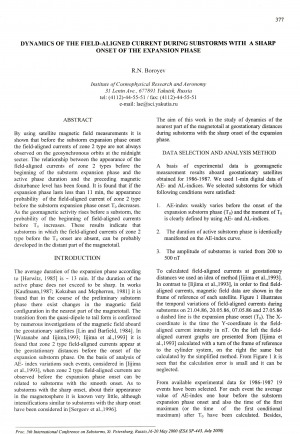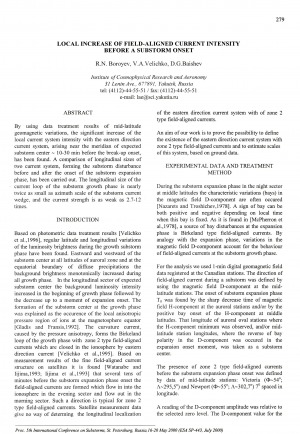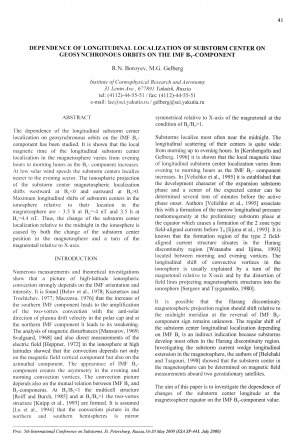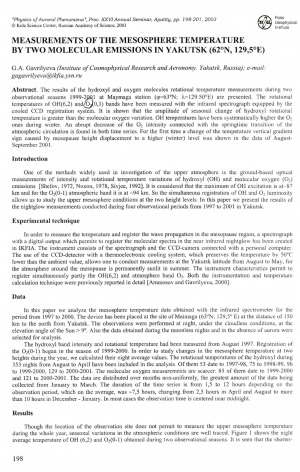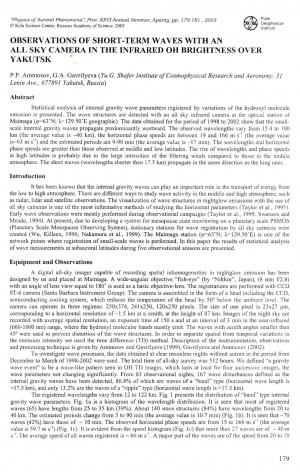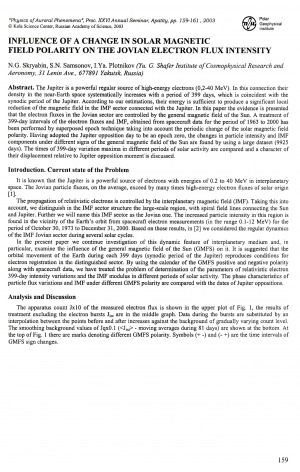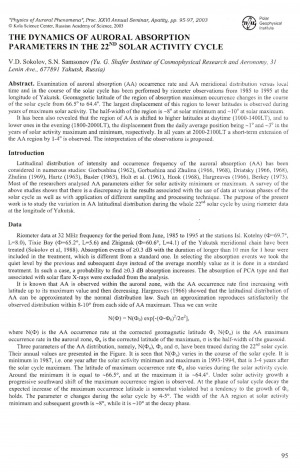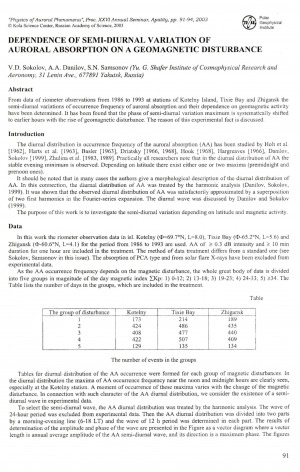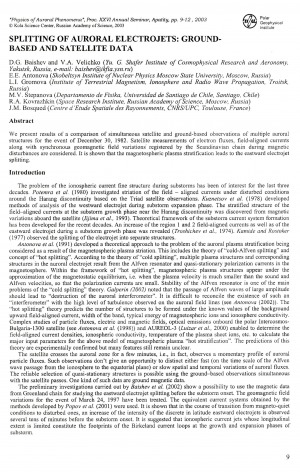Количество страниц: 4 с.
Boroyev, R. N. Dynamics of the field-aligned current during substorms with a sharp onset of the expansion phase / R. N. Boroyev // Proceedings of the Fifth International Conference on Substorms : 16-20 May 2000 Congress Centre of the Arctic and Antarctic Research Institute, St. Petersburg, Russia. − Noordwijk, Netherlands : European Space Agency, 2000. − P. 377-380.
Количество страниц: 4 с.
Boroyev, R. N. Local increase of field-aligned current intensity before a substorm onset / R. N. Boroyev, V. A. Velichko, D. G. Baishev // Proceedings of the Fifth International Conference on Substorms : 16-20 May 2000 Congress Centre of the Arctic and Antarctic Research Institute, St. Petersburg, Russia. − Noordwijk, Netherlands : European Space Agency, 2000. − P. 279-282.
Количество страниц: 4 с.
Boroyev, R. N. Dependence of longitudinal localization of substorm center on geosynchronous orbits on the IMF Bγ-component / R. N. Boroyev, M. G. Gelberg // Proceedings of the Fifth International Conference on Substorms : 16-20 May 2000 Congress Centre of the Arctic and Antarctic Research Institute, St. Petersburg, Russia. − Noordwijk, Netherlands : European Space Agency, 2000. − P. 41-44.
Количество страниц: 4 с.
Gavrilyeva, G. A. Measurements of the mesosphere temperature by two molecular emissions in Yakutsk (62°N, 129,5°E) / G. A. Gavrilyeva // Physics of auroral phenomena : proceedings of the 26th annual seminar, 25 - 28 February 2003. – 2003. – P. 198-201.
Количество страниц: 3 с.
Ammosov, P. P. Observations of short-term waves with an all sky camera in the infrared oh brightness over Yakutsk / P. P. Ammosov, G. A. Gavrilyeva // Physics of auroral phenomena : proceedings of the 26th annual seminar, 25 -28 February 2003. – 2003. – P. 179-181.
Количество страниц: 3 с.
Skryabin, N. G. Influence of a change in solar magnetic field polarity on the Jovian electron flux intensity / N. G. Skryabin, S. N. Samsonov, I. Ya. Plotnikov // Physics of auroral phenomena : proceedings of the 26th annual seminar, 25 - 28 February 2003. – 2003. – P. 159-161.
Количество страниц: 3 с.
Sokolov, V. D. The dynamics of auroral absorption parameters in the 22nd solar activity cycle / V. D. Sokolov, S. N. Samsonov // Physics of auroral phenomena : proceedings of the 26th annual seminar, 25 - 28 February 2003. – 2003. – P. 95-97.
Количество страниц: 4 с.
Sokolov, V. D. Dependence of semi-diurnal variation of auroral absorption on a geomagnetic disturbance / V. D. Sokolov, A. A. Danilov, S. N. Samsonov // Physics of auroral phenomena : proceedings of the 26th annual seminar, 25 - 28 February 2003. – 2003. – P. 91-94.
Количество страниц: 4 с.
Effect of Bγ IMF in substorm current wedge formation / V. A. Velichko, R. N. Boroev, I. Ya. Plotnikov, D. G. Baishev // Physics of auroral phenomena : proceedings of the 26th annual seminar, 25 - 28 February 2003. – 2003. – P. 45-48.
Количество страниц: 3 с.
Splitting of auroral electrojets: ground-based and satellite data / D. G. Baishev, V. A. Velichko, E. E. Antonova, L. I. Gromova, M. V. Stepanova, R. A. Kovrazhkin, J. M. Bosqued // Physics of auroral phenomena : proceedings of the 26th annual seminar, 25 - 28 February 2003. – 2003. – P. 9-11.
